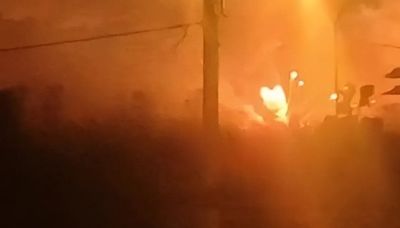Search results
Crimea (/ k r aɪ ˈ m iː ə / ⓘ kry-MEE-ə) is a peninsula in Eastern Europe, on the northern coast of the Black Sea, almost entirely surrounded by the Black Sea and the smaller Sea of Azov. The Isthmus of Perekop connects the peninsula to Kherson Oblast in mainland Ukraine.
- 27,000 km² (10,000 sq mi)
- Ukraine
- 1,545 m (5069 ft)
- 2,416,856 (2021)
- Overview
- Geography
Crimea, autonomous republic, southern Ukraine. The republic is coterminous with the Crimean Peninsula, lying between the Black Sea and the Sea of Azov. In 2014 Russia covertly invaded and illegally annexed Crimea, a move that was denounced by the international community. Area 10,400 square miles (27,000 square km). Pop. (2001) 2,033,736; (2013 est....
The peninsula is connected on the northwest to the mainland by the Perekop Isthmus, a 5-mile- (8-km-) wide strip of land that has been the site of numerous battles for the control of Crimea. Between Crimea and the mainland to the north lies Syvash (“Putrid Sea”), a network of shallow inlets that is separated from the Sea of Azov by the Arabat Spit, a 70-mile- (113-km-) long sandbar along the eastern shore of Crimea. Brines from Syvash supply chemical plants at Krasnoperekopsk in northwestern Crimea.
Crimea itself comprises three regions. The first of these, consisting of the northern and central part of Crimea (which constitutes about three-fourths of the peninsula), is made up of a level plain that slopes down gently from south to north. This steppe region is under intensive agricultural cultivation, with winter wheat, corn (maize), potatoes, and sunflowers among the main crops. The climate is dry and continental, and additional water supplies are brought by canal from the Dnieper River at Kakhivka (Kakhovka).
The second region, the Kerch Peninsula, thrusts eastward toward the Russian kray (territory) of Krasnodar and consists of low hills rich in iron ore. The mud volcanoes and mineral springs that dot the landscape have given rise to a spa industry that draws both domestic and international tourists. There is steppe vegetation, but large-scale agricultural development has been hindered by the limited availability of suitable soil. Heavier industry is concentrated in the city of Kerch, traditionally a centre of large-scale iron ore mining. A 12-mile- (19-km-) long bridge spans the Kerch Strait, linking Crimea and Russia.
The third region is made up of the alpine fold mountains of the south, which form three chains parallel to the southern coast. These chains of flat-topped limestone blocks, known as the Crimean Mountains, rise successively higher from the north to the south (with steep-faced southern slopes and gentler northern slopes), topping out at 5,069 feet (1,545 metres) at Mount Roman-Kosh. This range drops steeply to the sea, where there is a narrow coastal plain broken by cliffs and headlands. Precipitation in the mountainous belt is significantly greater than elsewhere in Crimea, its average annual rainfall totals exceeding 23 inches (600 mm). The mountains have a luxuriant and varied forest vegetation of oak, beech, hornbeam, maple, and other species, which give way to juniper and meadow grasses at higher elevations. The southern coast, sheltered by the mountains from cold northern air, has a mild Mediterranean climate. Many exotic plants have been introduced, such as cypress, oleander, almond, and myrtle, together with palms and other subtropical flora.
On the lower mountain slopes of the south are many vineyards. Tobacco is important, as are flowers for perfume. Most towns are engaged in processing farm produce, especially wine making. Simferopol, the administrative centre of the republic, is located in the foothills of the Crimean Mountains. It has a diversified economy of light industry and services, and it is a major regional transportation hub. The Crimean Astrophysical Observatory, located in Nauchny, is one of the largest astronomical research facilities in eastern Europe. There are a number of stone quarries, especially for limestone and diorite. Along the southern coast, tourism is extremely important, with Yalta, Gurzuf, Alushta, and Alupka among the main centres. The port city of Sevastopol serves as the headquarters of the Russian Black Sea Fleet.
Special offer for students! Check out our special academic rate and excel this spring semester!
- The Editors of Encyclopaedia Britannica
The Republic of Crimea is a republic of Russia, comprising most of the Crimean Peninsula, but excluding Sevastopol. Its territory corresponds to the pre-2023 territory of Autonomous Republic of Crimea, a subdivision of Ukraine. Russia occupied and annexed the peninsula in 2014, although the annexation remains internationally unrecognized.
- 26,081 km² (10,070 sq mi)
- North Caucasus
History of Crimea. Ancient settlements in Crimea and surrounding area. Coin from Chersonesus with Artemis, deer, bull, club and quiver ( c. 300 BC) The recorded history of the Crimean Peninsula, historically known as Tauris, Taurica ( Greek: Ταυρική or Ταυρικά ), and the Tauric Chersonese ( Greek: Χερσόνησος ...
May 31, 2012 · Crimea profile - BBC News. 31 July 2023. War in Ukraine. Crimea lies on a peninsula stretching out from the south of Ukraine between the Black Sea and the Sea of Azov. It is separated from...
People also ask
Is Crimea rightfully Russian or Ukrainian?
Why does Crimea belong with Russia?
Is it safe to visit Crimea?
What is the truth about Crimea?
Crimea in the Soviet Union and independent Ukraine. White Russian refugees gathering at a Crimean port during the Russian Civil War. When the Revolution of 1917 led to the collapse of the Russian Empire, the remaining Crimean Tatars declared Crimea to be an independent democratic republic.
Jul 12, 2018 · How Crimea’s Complex History With Russia Dates Back to the 19th Century. The peninsula has long loomed large for Russian and Soviet leaders. By: Alice Popovici. Updated: August 21, 2023 ...


